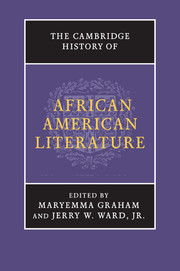Book contents
- Frontmatter
- Introduction
- PART I AFRICAN AMERICAN LITERATURE FROM ITS ORIGINS TO THE TWENTIETH CENTURY
- PART II AFRICAN AMERICAN LITERATURE IN THE TWENTIETH CENTURY
- PART III AFRICAN AMERICAN LITERATURE AS ACADEMIC AND CULTURAL CAPITAL
- 24 Children's and young adult literatures
- 25 From writer to reader: black popular fiction
- 26 Cultural capital and the presence of Africa: Lorraine Hansberry, August Wilson, and the power of black theater
- 27 African American literature: foundational scholarship, criticism, and theory
- 28 African American literatures and New World cultures
- Bibliography
- Index
- References
27 - African American literature: foundational scholarship, criticism, and theory
from PART III - AFRICAN AMERICAN LITERATURE AS ACADEMIC AND CULTURAL CAPITAL
Published online by Cambridge University Press: 28 May 2011
- Frontmatter
- Introduction
- PART I AFRICAN AMERICAN LITERATURE FROM ITS ORIGINS TO THE TWENTIETH CENTURY
- PART II AFRICAN AMERICAN LITERATURE IN THE TWENTIETH CENTURY
- PART III AFRICAN AMERICAN LITERATURE AS ACADEMIC AND CULTURAL CAPITAL
- 24 Children's and young adult literatures
- 25 From writer to reader: black popular fiction
- 26 Cultural capital and the presence of Africa: Lorraine Hansberry, August Wilson, and the power of black theater
- 27 African American literature: foundational scholarship, criticism, and theory
- 28 African American literatures and New World cultures
- Bibliography
- Index
- References
Summary
In 1899 during a lecture at a famous New York hotel, Paul Laurence Dunbar (1872–1906) responded with pain to a reporter's question. “We must write like white men. I do not mean imitate them, but our life is now the same … I hope that you are not one of those who would hold the negro down to a certain kind of poetry – dialect and concerning only scenes on the plantation.” Dunbar's words resonated for most African Americans who possessed the literacy and leisure necessary to produce poetry and prose toward the end of the Victorian era and on the verge of the explosion of artistic modernism in the United States. For this group, the critical strictures and proprieties of Edwardian era literary expression were remarkably straightforward – and desirable. Another more critical member of Dunbar's peers, Victoria Matthews, coined the term Race Literature at the turn-of-the-century Conference of Colored Women in the United States, hoping that the efforts written by a new generation of black writers would “utterly drive out the traditional Negro in dialect, – the subordinate, the servant as the type representing a race whose numbers were far into the millions.” The black critical voices embarrassed by the clownish, lascivious, and primitive minstrel stereotypes dominated the small network of African American journals, newspapers, and often denominational colleges at the beginning of the twentieth century.
- Type
- Chapter
- Information
- The Cambridge History of African American Literature , pp. 703 - 729Publisher: Cambridge University PressPrint publication year: 2011
References
- 1
- Cited by



